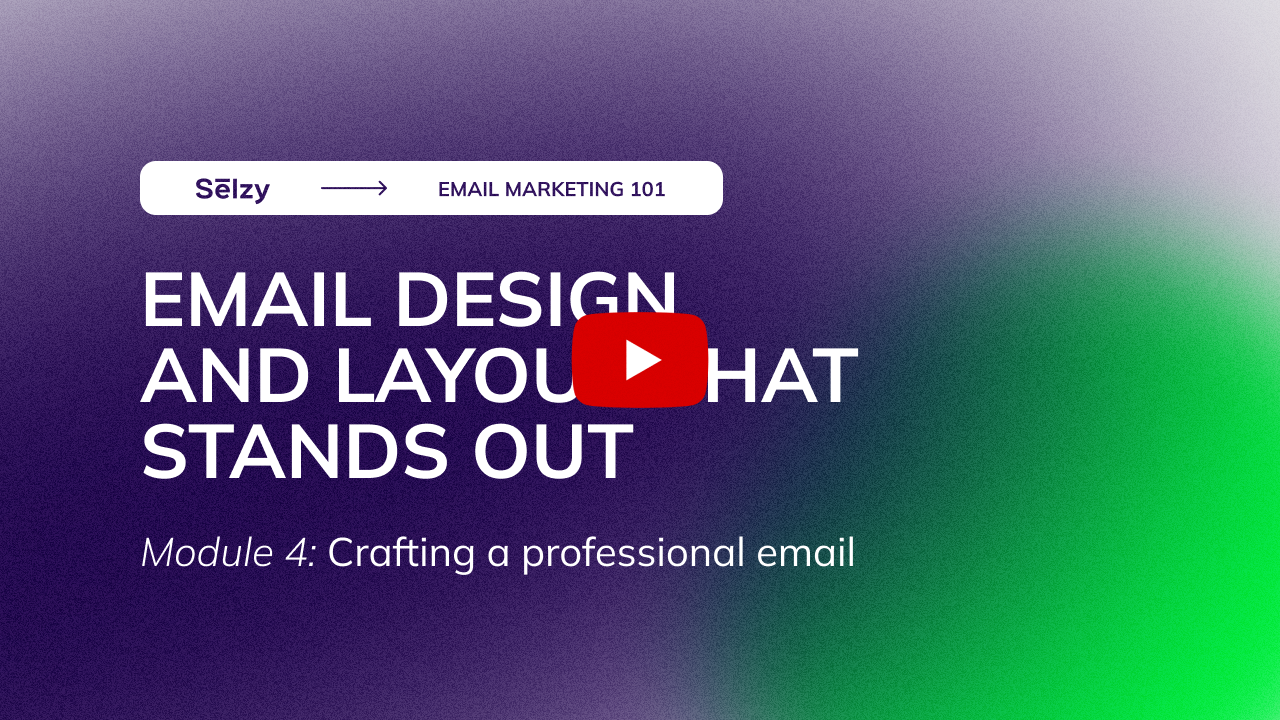Subject Line and Preheader: Dos and Don’ts
This is a transcript of lesson 13 of Email Marketing 101 Course by Selzy.

Hello! Welcome to Module 5. This module is all about preparing your email for sending. In the first lesson, we’ll talk about subject lines and preheaders, adding them to emails, and using them effectively.
An email subject is the first thing subscribers will see in their inboxes. It’s your chance to make a great first impression, so they click to read your email. That’s why catchy subject lines are crucial for successful campaigns. Let’s look at the dos and don’ts that will make or break your open rates, starting with positive examples.
Dos of subject line writing
Do #1: Keep it short
A lot of people read emails from mobile devices — take that into account. If you want them to see the entire subject line, we suggest using 40 characters, tops.

This visual is only available in a video lesson
Do #2: Be clear
People scan subject lines to decide whether they want to read the whole thing. The best tactic is getting down to business right away. A good email subject sets clear expectations of its content — briefly summarize your offer.

This visual is only available in a video lesson
Do #3: Personalize it
76% of customers expect personalized interactions from brands and marketers. People like being treated like people, not walking wallets. That’s why personalized email subject lines get you higher open rates and better engagement. Even small things, such as addressing your subscribers by their first names, can really make a difference.
But adding first names is not the only tactic. You can also add order numbers, birthday dates, location, a special milestone, and so much more!

This visual is only available in a video lesson
How to add customer data to subject lines? That’s where merge tags can help. Merge tags are variables that will change for each recipient. Almost all email marketing software tools have this feature. For example, here’s how it looks at Selzy: just click on the part of the text you want to insert the merge tag in and choose the tag you need!

This visual is only available in a video lesson
Do #4: Use emojis
When you send a newsletter, it competes with all the other newsletters your customers receive. That’s why it’s essential to grab attention.
Emojis are a great way to stand out in the inbox. However, don’t overuse them, or you will look spammy and annoying — stick to one or two.

This visual is only available in a video lesson
Do #5: Get creative
Clearly but briefly describing the offer is the most foolproof subject line tactic. But emails leave a lot of room for expressing your brand personality. Effective subject lines can be funny, provocative, or mysterious — people will click on them out of curiosity. If it fits your brand’s tone of voice, use humor, irony, or intriguing questions to draw attention.

This visual is only available in a video lesson
And that’s what you can do to create compelling subject lines that get you clicks. Now let’s look at some common subject line mistakes — the don’ts.
Don'ts of subject line writing
Don’t #1: Do not use weird symbols
The use of too many questions or exclamation marks? Small caps, zalgo text and other weird symbols both in email subjects and copies will trigger spam filters and drop your deliverability:
too many questions or exclamation marks
sᴍᴀʟʟ ᴄᴀᴘs
z̈́̾͆a̒͐̚l͊̔g͆̔́ó̓̐ t̔̀͘e͆͋̈́x͋̾͌ẗ́͊͌
and 𝑜𝑡ℎ𝑒𝑟 🅆🄴🄸🅁🄳 sʇuoⅎ
If you want an exciting look, focus on the email design or add a couple emojis to your subject line instead. And for highlighting certain parts of your email subject, use all caps but in moderation.

This visual is only available in a video lesson
Don’t #2: Do not use misleading subjects
We bet you’re annoyed with those emails with RE or FWD in their subject lines because you’ve never interacted with those senders! To put it simply, they look like spam.
Clickbaity-deceiving subjects like these trigger spam filters and are forbidden by the CAN-SPAM act.

This visual is only available in a video lesson
Don’t #3: Do not ignore proofreading
Imagine you prepared a fantastic promotional campaign with the subject line “Duck and cover, the ATOMIC sale is coming!”. The entire marketing department was excited, and even the CEO liked your idea. But you made a typo and didn’t notice it before sending it. The entire contact list got an email with an F-bomb in the subject line. The atomic sale, indeed.
To avoid public scandals and unprofessional looks, proofread everything before sending it. Too many typos, spelling, or grammar mistakes make your emails hard to read. Even worse, spelling errors might trigger spam filters, which will affect your deliverability in the future.

This visual is only available in a video lesson
What if you sent an email with a bad typo in the subject line? Depends on how serious it is. If it’s a minor mistake most people won’t notice. If not, send an “Oops!” email and try again. If it’s a grave error, send an apology email to everyone affected by your mistake and offer a promo code as compensation.
Don’t #4: Do not use clickbait
You’ve probably seen ad banners with headlines like:
You would NOT believe what scientists have found… Click to read
EARN $10000 by CLICKING HERE
What Happens If You Only Drink Orange Juice For A Week
These are good attention-grabbers. But, as you click to read, the content might not be as enjoyable as it was marketed to you. I guess you already know: it’s called clickbait. Using sensational email subjects can get you clicks, for sure. However, your subscribers will be disappointed when they open your email — they won’t read it through, let alone interact with your CTA.
There are better attention-grabbing tactics out there. For high-quality clicks, give your subscribers an enticing offer, helpful information, or even a fun read. Highlight that reason in the subject line — and you’ll get higher open rates and CTRs.

This visual is only available in a video lesson
Don’t #5: Do not be too vague
Don’t get it wrong: we’re not against intriguing subject lines. A little mystery, if done right, will get you clicks. But wait a second… if the entire email content is in the subject, do people really need to open it?
On the other hand, if your subject line is too ambiguous, your subscribers won’t be interested enough to open the email.

This visual is only available in a video lesson
Think of subject lines as profile pictures on a dating app. It’s the first thing users see and the main reason they swipe right or left. However, your profile has a bio that affects the choice too. Your email also has a “bio” — it’s a preheader.
Preheader texts, like subject lines, are essential in conquering your subscribers’ attention. It’s one of the first things they see! So, a good preheader can save the day if your email subject isn’t enticing enough. Let’s discuss what makes a clickable preheader — and which mistakes you should avoid.
Dos of preheader writing
Do #1: Expand on the subject line
Imagine that your email is an article posted on The Washington Post website.

This visual is only available in a video lesson
This article has a heading and a subheading. The heading acts as an attention-grabber — it only gives you a general idea that the article is about architecture. The subheading is more specific — it explains that the article is about British architecture and its flaws.
Treat your preheader texts the same way — they should give more details on what you have to offer, rather than just repeat what you have just said in the subject line.

This visual is only available in a video lesson
Do #2: Include a CTA
A solid call to action is vital for conversions. A clear CTA that conveys the potential profit for customers is key to successful campaigns that generate purchases.
Incorporating a CTA in the preheader text is not mandatory, but it works. Suppose customers can evaluate the potential benefits of opening your email right away. In that case, they are more likely to not just open it but also do what you’re asking them to do.

This visual is only available in a video lesson
Do #3: Personalize
Some email subject lines just can’t be personalized. What if you want to include a purchased item, but its name is too long for a subject line? The solution is personalizing a preheader instead.

This visual is only available in a video lesson
Do #4: Optimize for mobile devices
Mobile email apps are a bit space-starved. That’s why let’s also optimize preheader texts, so they display correctly on all devices. The perfect length for a preheader is 40–50 characters.

This visual is only available in a video lesson
Do #5: Incentivize your audience
Trying to retell the entire email copy in your preheader text is futile — not only because your preheader will turn into a novel. Imagine a movie trailer that retells the whole plot. After watching it, you don’t even need to go to the cinema — you already know who dies and who finds love.
The takeaway is, don’t “spoil” your email in the preheader. Keep it a bit mysterious.

This visual is only available in a video lesson
A good preheader can enhance the effect of a good email subject or even save the day if you mess up the subject line. Now let’s tackle some don’ts of preheader writing.
Don'ts of preheader writing
Don’t #1: Do not repeat the subject line
Imagine that you messed up the subject line. It happens to the best of us. Even in this case, you still can get your clicks with a decent preheader.
Treat preheaders like your second chance to make a good impression. There are better tactics than paraphrasing or straight-up copypasting your subject line.

This visual is only available in a video lesson
Don’t #2: Do not ignore the preheader
If you don’t set up the preheader, it will be done automatically — subscribers will see the first line of your email. Sometimes it’s not that bad. However, you can end up with something like this:

This visual is only available in a video lesson
Preheaders like this one don’t make a good impression. Some of your subscribers will open it regardless — but a descriptive custom preheader text will get you many more clicks.

This visual is only available in a video lesson
Don’t #3: Do not contradict the subject line
Imagine an exhausted parent who screams at their child: “Stop running and stand still!”. This is what you look like to your subscribers if your preheader mismatches your subject line.

This visual is only available in a video lesson
Even if you’re making an email digest of several blog articles, focus on one topic in your subject line and preheader. A better tactic for cases like this is just saying that this email is a digest.

This visual is only available in a video lesson
Congrats! That’s all you need to know about subject lines and preheaders. In the next lesson, we’ll discuss unsubscribe buttons — what they are, why you need them, and where to put them in your email. Stay tuned!
This is a transcript of lesson 13 of Email Marketing 101 Course by Selzy.